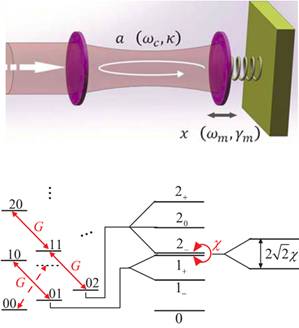Time:2013-08-22ClickTimes:
A cavity
optomechanical system, consisting of an optical cavity with a macroscopic
movable mirror, makes use of the high-Q optical mode to enhance the
interaction between light and the mechanical oscillator. Such optomechanical
interaction enables not only high-precision measurement of mass, force and
displacement, but also precise manipulation of the mechanical motion, for
example, cooling and amplification of the mechanical motion. When the
mechanical oscillator is cooled to the quantum ground state, macroscopic
quantum phenomenon can be explored in the oscillators containing more than
10^20 atoms or molecules.
Usually, the cavity optomechanical system is dominated by linear
interaction, while the nonlinearity is extremely weak. Now, a report in
Physical Review Letters describes the resonant enhancement of nonlinearity
by orders of magnitude. In this work, the team led by Professor Yun-Feng
Xiao and Professor Qihuang Gong at Peking University takes advantage of
light-enhanced linear optomechanical coupling to create the normal mode
splitting, and through frequency matching the nonlinear interaction becomes
resonant, which greatly boosts the nonlinearity. They demonstrate parametric
down-conversion for polariton pair generation, including photon-like
polaritons, phonon-like polaritons and mixed photon-phonon polaritons. Such
nonlinear interaction offers a promising way for harnessing the
optomechanical nonlinearity to manipulate photons and phonons, and holds
great potential for quantum information processing.

|
Top: Sketch of an optically driven optomechanical system.
Bottom: Energy
level diagram of the system.
|
References: Yong-Chun Liu, Yun-Feng Xiao*, You-Ling Chen, Xiao-Chong Yu, and
Qihuang Gong*, “Parametric Down-Conversion and Polariton Pair Generation in
Optomechanical Systems,” Phys. Rev. Lett. 111, 083601 (2013)
